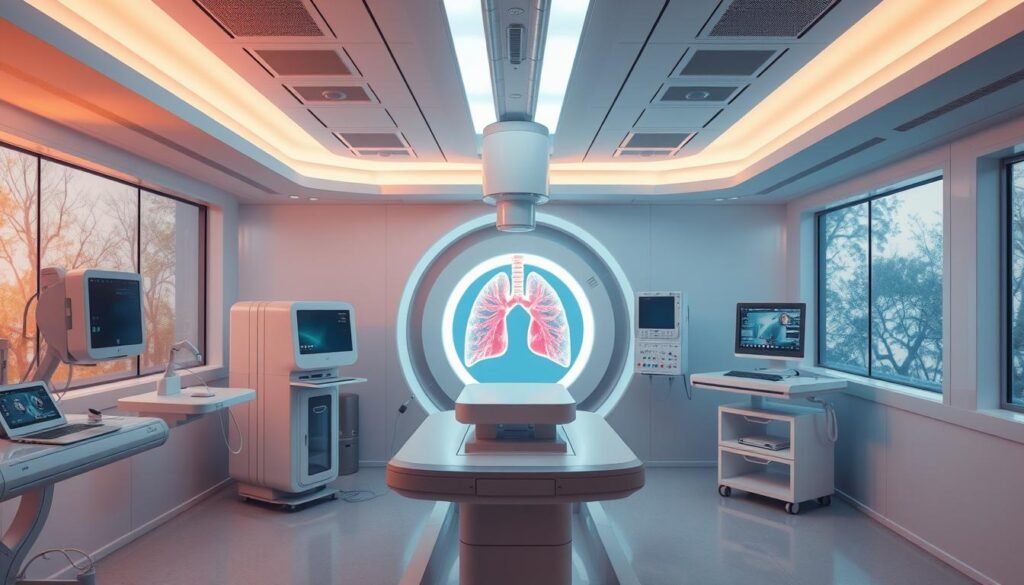Small cell lung cancer (SCLC) makes up about 15% of all lung cancers. Despite this, it’s one of the hardest to treat due to fast growth and high chance of relapse. Most patients with extensive-stage (ES) SCLC have spread-out disease from the start. This makes finding effective treatments quickly very important.
For those with extensive-stage disease, treatment isn’t simple. It can’t be fixed in one place. A mix of treatments is needed to help patients live longer and better.
This piece will cover treatment paths for extensive stage small cell lung cancer. We’ll talk about chemotherapy, immunotherapy, and help for symptoms. Knowing these can help patients and their doctors plan treatments that aim to improve life and lengthen survival.
Key Takeaways
- Small cell lung cancer represents about 15% of all lung cancers.
- Extensive stage SCLC typically presents with widespread disease, complicating treatment.
- Effective treatment options include chemotherapy, immunotherapy, and radiation therapy.
- The prognosis for extensive stage SCLC remains poor, with a 5-year survival rate of around 2%.
- Understanding treatment strategies can significantly impact patient outcomes.
Introduction to Small Cell Lung Cancer
Small Cell Lung Cancer (SCLC) accounts for about 15 percent of lung cancers. It grows quickly and spreads early, making it different from other lung cancers. Mostly, heavy and former smokers get diagnosed with this aggressive cancer. Knowing about it helps in finding the right treatment.
Within SCLC, there are two main types of lung cancer: small cell carcinoma, or oat cell cancer, and combined small cell carcinoma. If someone has limited-stage SCLC, doctors often suggest chemotherapy and radiation therapy. They target the chest and sometimes follow with brain radiation to stop cancer from spreading.
Early-stage small cell lung cancer might be treated with surgery if found early. The usual treatment plan includes using medicines that fight cancer throughout the body. Doctors may also use treatments that help the immune system fight cancer.
Because this cancer is very aggressive, catching it early and treating it fully is very important. For more details on how to treat it effectively, you can check here. Thanks to new research, patients have better treatment options now than ever before.
| Type | Description |
|---|---|
| Small Cell Carcinoma | Also known as oat cell cancer; it is the most common form of SCLC. |
| Combined Small Cell Carcinoma | Contains a mix of small cell cancer and non-small cell lung cancer. |
Understanding Extensive Stage Small Cell Lung Cancer
Extensive Stage Small Cell Lung Cancer (SCLC) reaches a critical point where cancer spreads wide, even beyond the chest. At this stage, surgeries like removing lung lobes don’t work.
People with this advanced cancer often suffer from harsh coughing, feeling out of breath all the time, and feeling generally unwell. These symptoms show how aggressive the cancer is, pointing to its rapid spread.
While early stages may affect one lung or nearby nodes, extensive SCLC forecasts a grim outlook. At diagnosis, 70–80% of SCLC patients find themselves at this advanced stage. Chemotherapy, often paired with immunotherapy, is the main treatment approach.
The TNM staging system plays a key role in evaluating the disease’s extent. It labels extensive disease based on its reach, emphasizing cancer’s broad impact. Treatment plans focus on the patient’s specific needs and the cancer’s advanced stage, aiming for the best care possible.
| Stage | Definition | Treatment |
|---|---|---|
| Limited Disease | Cancer confined to one area of the chest | Chemotherapy with or without radiotherapy |
| Extensive Disease | Cancer spread beyond a single site, potentially to the chest and other body parts | Chemotherapy, possibly with immunotherapy, and brain radiotherapy |
Grasping the intricacies of extensive stage SCLC helps in crafting impactful treatment plans. It focuses on the unique needs of patients battling this daunting cancer form.
Diagnosis of Extensive Stage Small Cell Lung Cancer
To diagnose extensive stage SCLC, it starts with looking at the patient’s medical history and a detailed physical check. It is crucial to use different tests for lung cancer. Especially imaging studies help understand how far the disease has spread.
Chest X-rays and CT scans are key in spotting tumors and finding if cancer has spread. These scans show the tumor’s size and extent. Then, a biopsy is usually needed to confirm cancer’s presence. This step is key to figure out the tumor details, which will guide the treatment plan.
Getting an accurate diagnosis is essential for effectively managing extensive stage SCLC. Quick actions based on diagnosis results can hugely help patient outcomes. For more information on diagnosing and treating this type of lung cancer, the NCCN Guidelines are a great resource.
Initial Treatment Strategies
Starting treatment for extensive stage small cell lung cancer (SCLC) often includes chemotherapy and immunotherapy. Etoposide along with cisplatin or carboplatin are common choices. They aim to shrink the tumor, ease symptoms, and help patients live longer.
Adding immunotherapy, like PD-L1 inhibitors, to chemotherapy has shown promise. Studies show that this combination improves patient outcomes. In fact, combining these treatments has shown to significantly increase survival.
Tailoring the treatment to each patient’s health is crucial. Atezolizumab, for example, has improved survival from 10 to 12 months with carboplatin and etoposide. These strategies aim to extend life and enhance the quality of life for those with extensive stage SCLC.
| Treatment Regimen | Hazard Ratio (OS) | Progression-Free Survival (PFS) | Treatment-Related Adverse Events |
|---|---|---|---|
| PD-L1 Inhibitor + Etoposide-Platinum | 1.40 (95% CI, 1.09-1.80) | Improved | Similar to Etoposide Alone |
| Bevacizumab + Etoposide | 1.54 (95% CI, 1.09-2.27) | Best PFS | Grades 3-5 Adverse Events: Odds Ratio 4.24 (95% CI, 1.26-14.57) |
| Atezolizumab + Carboplatin + Etoposide | Improved (OS from 10 to 12 months) | Improved | No additional toxicity |
Doctors work hard to find the best treatment plan for each patient. They look for the most effective regimen to make informed decisions together during treatment.
Chemotherapy for Extensive Stage Small Cell Lung Cancer
Chemotherapy is key for treating extensive stage small cell lung cancer (SCLC). This aggressive disease often requires strong treatments early. A typical treatment includes cisplatin or carboplatin with etoposide. These drugs work together to shrink the tumor and ease symptoms.
A lot of research from 1973 to 1999 looked at chemotherapy for this cancer. Around 75% of these studies used a mix of cisplatin and etoposide. While research comparing carboplatin and cisplatin is rare, it has been done.
Treatment plans might change based on how well they work. One study compared high doses of etoposide with cisplatin to standard doses. There’s also research on maintenance chemotherapy. Its goal is to help patients live longer and better.
Since cancer often comes back, ongoing changes to chemotherapy are necessary. Many patients see their cancer return despite initial treatment success. That’s why a team approach is crucial. It helps manage side effects like nausea and tiredness, improving quality of life.
For more detailed information, it’s a good idea to read up on chemotherapy in small cell lung cancer.
Immunotherapy: A New Hope
Immunotherapy is changing the game for treating advanced small-cell lung cancer (SCLC). It uses the body’s immune system to fight cancer cells. This opens new doors for how we treat cancer. Drugs like atezolizumab (Tecentriq) and durvalumab (Imfinzi) play a big role in this new approach.

Studies show that mixing immunotherapy with chemotherapy can help patients live longer. These studies found a 2-2.7 month increase in survival for patients getting this new first-line therapy. This is a big deal because we haven’t had new treatments for this cancer in over 30 years.
- Small-cell lung cancer is about 15% of all lung cancer cases worldwide.
- About 75-80% of SCLC patients already have cancer spread when they’re diagnosed.
- Every year, more than 200,000 people worldwide get diagnosed with SCLC. It mostly affects older men who smoke a lot.
- Patients with relapsed SCLC only live about 2-3 months without treatment.
- Atezolizumab and durvalumab improve survival when added to the usual chemotherapy in the first-line treatment.
Bringing immunotherapy into the treatment plans for SCLC is a big turning point. It offers hope to many who previously had few options. Researchers are working hard to find even more ways to use immunotherapy. They aim to increase how long patients live and their quality of life.
Targeted Therapy: Emerging Options
Targeted therapy is a new hope for treating small cell lung cancer (SCLC). It aims to attack specific genetic changes in cancer cells. This method tailors treatment to fit each patient’s unique genes. Unlike regular chemotherapy, it tries to avoid harming healthy cells. This makes it a key part of fighting SCLC.
Right now, we don’t have many targeted treatments for SCLC. But, research is finding new options that could work better. For instance, Tarlatamab-dlle (Imdelltra) attacks a protein named DLL3 on SCLC cells. People taking this drug have seen their tumors get smaller. This points towards more custom treatment plans.
New treatments like Lurbinectedin (Zepzelca) are also emerging. It’s for patients who didn’t respond well to standard chemotherapy. Another option, Nivolumab, is for late-stage SCLC. It’s used after other treatments failed. These advances show the ongoing search for better ways to fight cancer.
Below is a table with some new targeted therapy options for SCLC:
| Medication | Mechanism of Action | Potential Benefits | Current Status |
|---|---|---|---|
| Tarlatamab-dlle (Imdelltra) | Targets DLL3 protein on SCLC cells | Tumor shrinkage in some patients | Approved for clinical use |
| Lurbinectedin (Zepzelca) | Alters DNA and inhibits cancer cell growth | Effective after platinum therapy | Approved for use in metastatic SCLC |
| Nivolumab (Opdivo) | Immune checkpoint inhibitor | Improves outcomes in advanced SCLC | FDA-approved |
As we learn more about targeting cancer cells, the future looks brighter for SCLC treatment. Finding the genetic keys inside cancers is crucial. It could lead to big improvements in survival for SCLC patients. For more details on targeted therapy, check out this resource.
Role of Radiation Therapy
Radiation therapy is crucial for treating stage SCLC, especially for symptom management. It reduces pain, controls bleeding, and tackles tumors in the bones or brain. Serving mainly for relief, it can be a standalone treatment or used with others to improve life quality.

Radiation therapy is given daily, usually 5 days a week for 3 to 7 weeks. Techniques like intensity modulated radiation therapy (IMRT) are vital near vital organs, like the spine. Volumetric modulated arc therapy (VMAT), on the other hand, offers quick radiation delivery.
Stereotactic body radiation therapy (SBRT) is another method. It delivers high radiation doses in 1 to 5 sessions targeting tumors accurately. This approach is fast and aims to be as effective as longer treatments.
Radiation therapy for SCLC can cause side effects like:
- Skin changes
- Hair loss
- Fatigue
- Nausea and vomiting
- Loss of appetite
- Weight loss
- Cough and breathing problems
- Shortness of breath
- Sore throat and difficulties swallowing
- Memory loss and headaches
- Trouble thinking
Using radiation therapy for SCLC helps ease symptoms and manage extra issues from this aggressive cancer. Effective symptom management is key to improving patients’ treatment journey.
Palliative Care and Supportive Treatment
Palliative care is key for those with extensive stage small cell lung cancer (SCLC). It aims to ease symptoms and better the quality of life. This often involves handling pain, breathlessness, and emotional distress. It makes treatment easier to manage.
Supportive treatment is vital for meeting patient needs fully. This includes procedures like thoracentesis, which takes fluid out of the chest. Pleurodesis stops fluid from coming back. Draining fluid around the heart with pericardiocentesis helps when cancer spreads. These actions are crucial for handling symptoms well.
Besides medical procedures, palliative care offers emotional support and counseling. It provides nutritional advice and makes sure care is well-coordinated. Teams of specialists like nurses, social workers, and pharmacists play a big part. They help tackle the many challenges that come with treatment.
Palliative care is available in many places, like hospitals and clinics. Starting it early in the treatment helps a lot with symptom control. It leads to a better quality of life. Adding pain relief and services like massage shows how supportive treatments are important.
| Supportive Treatment Options | Description | Benefits |
|---|---|---|
| Thoracentesis | Procedure to remove excess fluid from the pleural space. | Improves breathing and reduces discomfort. |
| Pleurodesis | Technique to prevent pleural fluid accumulation. | Reduces the frequency of fluid build-up. |
| Pericardiocentesis | Draining fluid around the heart. | Allows for improved heart function and lessens pressure. |
| Photodynamic Therapy | Involves a light-activated drug to unblock airways. | Aides in better breathing and airway clearance. |
| Stent Placement | Insertion of a stent to keep airways open. | Facilitates easier breathing in cases of blockage. |
Focusing on palliative care and supportive treatment helps healthcare providers improve care for SCLC patients. It is part of a full plan to make patient well-being better and handle symptoms effectively.
Side Effects Management During Treatment
It’s crucial to handle side effects well during SCLC treatment. This improves life quality and helps patients stick to treatment. They may face side effects from chemotherapy and immunotherapy, which disrupt their daily lives.

- Nausea: This issue can majorly impact those on chemotherapy, harming their appetite and health.
- Fatigue: Patients often feel very tired, which lowers activity and affects their mood.
- Weak immune response: Chemotherapy weakens the immune system, making infections more likely.
A good management plan is key. Such plans often include:
- Medications: Drugs for nausea and growth factors can lessen side effects.
- Supportive therapies: Things like physical therapy and nutritional advice help combat fatigue and keep energy up.
- Regular monitoring: Keeping an eye on symptoms lets doctors update the treatment as needed.
These methods greatly reduce side effects. This leads to better results for those fighting advanced SCLC.
| Side Effect | Management Strategies |
|---|---|
| Nausea | Anti-nausea medications, dietary changes |
| Fatigue | Rest periods, physical therapy |
| Weakened Immune Response | Infection prevention measures, growth factors |
Clinical Trials: Exploring New Frontiers
Clinical trials are key in making new treatments for small cell lung cancer (SCLC) better. They offer patients new experimental treatments that aren’t available otherwise. Taking part in these trials helps improve how we treat SCLC and patient outcomes.
Recent studies have shown big improvements in the survival of SCLC patients. This is thanks to immune-checkpoint inhibitors used with chemotherapy. Trials like Impower133 and CASPIAN showed median survival times of 12.3 and 13.0 months. These findings underline the value of continuing clinical trials.
Most SCLC cases are discovered at stage IV, which shows the urgency for new therapy methods. The systemic immune-inflammation index (SII) helps predict how advanced SCLC will respond to treatments. This leads to more personalized therapy strategies. Drugs like lurbinectedin and anti-DLL3 agents are some examples.
If you have SCLC, talk to your healthcare team about joining a clinical trial. It’s a way to access the latest treatments and help future SCLC care improve. Being part of these studies offers hope and advances SCLC research.
Treatment Options for Extensive Stage Small Cell Lung Cancer
Patients with extensive stage SCLC face a tough fight. Their treatment uses different methods to help them. It combines chemotherapy and immunotherapy. This strong mix targets the cancer’s aggressive spread.
Chemotherapy uses drugs like etoposide and cisplatin or carboplatin. These drugs attack the cancer cells fast. Alongside chemotherapy, new immunotherapy drugs like atezolizumab and durvalumab are used. They open new paths for treatment and may help patients live longer.
Radiation therapy is key for treating extensive stage SCLC. It helps with symptoms like shortness of breath caused by cancer spreading. For those who need more options, clinical trials offer new therapies. Through these trials, patients can try treatments not yet widely available.
Treating extensive stage SCLC needs a team of doctors. This includes oncologists, radiologists, and palliative care experts. They work together to make personalized treatment plans. These plans aim to improve the patient’s quality of life.
It’s important for patients and their families to talk about treatment options. Staying informed helps them be part of the decision-making process. Knowing about clinical trials is also useful. It helps patients take a more active role in their care.
Conclusion
Knowing how to treat extensive stage small cell lung cancer (SCLC) is key for better outcomes. Recent progress, like adding immunotherapies nivolumab and pembrolizumab, brings hope. These treatments, especially when combined, have helped patients live longer without the disease worsening.
Palliative care is also crucial in making patients more comfortable. It’s very important to use a team approach. This mixes harsh treatments with supportive care. New research is opening doors to even more options. Learn more about these advances here.
The fight against SCLC requires determination and focus on new solutions. Being part of clinical trials and supporting new treatments are vital steps forward. They help make living longer a possibility for more patients facing this tough battle.